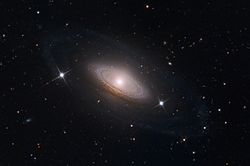astro.wikisort.org - Galaxy
NGC 4698 is a barred spiral galaxy[5] located around 55[3] million light years away from Earth in the constellation of Virgo. It belongs to the Virgo Cluster of galaxies and is positioned near the northeastern edge of this assemblage.[4] The morphological classification of NGC 4698 in the De Vaucouleurs system is SA(s)ab,[3] which indicates a purely spiral structure with moderate to tightly wound arms.[7] It is inclined to the line of sight from the Earth by an angle of 53° along a position angle of 170°.[8]
| NGC 4698 | |
|---|---|
 NGC 4698 imaged with the 32-inch Schulman Telescope at Mount Lemmon Observatory | |
| Observation data (J2000 epoch) | |
| Constellation | Virgo |
| Right ascension | 12h 34m 20.310s[1] |
| Declination | +08° 11′ 51.94″[1] |
| Helio radial velocity | 1,002[2] km/s |
| Distance | 54.8 Mly (16.8 Mpc)[3] |
| Group or cluster | Virgo Cluster |
| Apparent magnitude (V) | 10.6[4] |
| Apparent magnitude (B) | 11.46[5] |
| Characteristics | |
| Type | SA(s)ab[3] |
| Apparent size (V) | 4′.0 × 2′.9[4] |
| Notable features | Seyfert-2 galaxy[6] |
| Other designations | |
| PGC 43254, UGC 7970, VCC 2070 | |
A unique feature of this galaxy is that the stars and dust of the nuclear disk are rotating in a direction that is aligned perpendicularly to the galactic disk. The bulge likewise appears elongated out of the galactic plane. This unusual alignment may have been the result of a past merger event.[5]
NGC 4698 is classified as a Seyfert-2 galaxy with an active galactic nucleus, which displays a prominent emission of radio and X-ray energy from the core while showing narrow emission lines in the optical spectrum.[6] The unified model of Seyfert galaxies proposes that the nucleus of a Seyfert 2 galaxy is obscured by a thick torus of gas and dust. However, the varying X-ray emission of the core of NGC 4698 shows little indication of being obstructed, suggesting instead that the source of the energy emission is generally unobscured but anemic in nature.[9]
Gallery
- NGC 4698 (SDSS DR14)
- NGC 4698 (HST)
- NGC 4698 by a Schulman telescope at Mt. Lemmon, AZ.
References
- Skrutskie, Michael F.; Cutri, Roc M.; Stiening, Rae; Weinberg, Martin D.; Schneider, Stephen E.; Carpenter, John M.; Beichman, Charles A.; Capps, Richard W.; Chester, Thomas; Elias, Jonathan H.; Huchra, John P.; Liebert, James W.; Lonsdale, Carol J.; Monet, David G.; Price, Stephan; Seitzer, Patrick; Jarrett, Thomas H.; Kirkpatrick, J. Davy; Gizis, John E.; Howard, Elizabeth V.; Evans, Tracey E.; Fowler, John W.; Fullmer, Linda; Hurt, Robert L.; Light, Robert M.; Kopan, Eugene L.; Marsh, Kenneth A.; McCallon, Howard L.; Tam, Robert; Van Dyk, Schuyler D.; Wheelock, Sherry L. (1 February 2006). "The Two Micron All Sky Survey (2MASS)". The Astronomical Journal. 131: 1163–1183. doi:10.1086/498708. ISSN 0004-6256.
- Crook, Aidan C.; et al. (February 2007), "Groups of Galaxies in the Two Micron All Sky Redshift Survey", The Astrophysical Journal, 655 (2): 790–813, arXiv:astro-ph/0610732, Bibcode:2007ApJ...655..790C, doi:10.1086/510201, S2CID 11672751.
- de Looze, Ilse; et al. (October 2011), "The reliability of [C II] as an indicator of the star formation rate", Monthly Notices of the Royal Astronomical Society, 416 (4): 2712–2724, arXiv:1106.1643, Bibcode:2011MNRAS.416.2712D, doi:10.1111/j.1365-2966.2011.19223.x.
- Finlay, W. H. (2003), Concise Catalog of Deep-sky Objects: Astrophysical Information for 500 Galaxies, Clusters and Nebulae, Springer, p. 175, ISBN 978-1852336912.
- Corsini, E. M.; et al. (June 2012), "Polar bulges and polar nuclear discs: the case of NGC 4698", Monthly Notices of the Royal Astronomical Society: Letters, 423 (1): L79–L83, arXiv:1204.2265, Bibcode:2012MNRAS.423L..79C, doi:10.1111/j.1745-3933.2012.01261.x, S2CID 119099390.
- Georgantopoulos, I.; et al. (September 2003), "Chandra Observations of NGC 4698: A Seyfert 2 Galaxy with No Absorption", The Astrophysical Journal, 594 (2): 704–708, arXiv:astro-ph/0305488, Bibcode:2003ApJ...594..704G, doi:10.1086/377120, S2CID 13982986.
- Buta, Ronald J.; et al. (2007), Atlas of Galaxies, Cambridge University Press, pp. 13–17, ISBN 978-0521820486.
- Giovanardi, C.; et al. (March 1996), "Near-Infrared Low-Resolution Mapping of Early-Type Spirals", Astronomical Journal, 111 (2): 1086–1097, Bibcode:1996AJ....111.1086G, doi:10.1086/117854.
- Tran, Hien D.; et al. (January 2011), "Indecent Exposure in Seyfert 2 Galaxies: A Close Look", The Astrophysical Journal Letters, 726 (2): L21, arXiv:1012.1865, Bibcode:2011ApJ...726L..21T, doi:10.1088/2041-8205/726/2/L21, S2CID 119190993.
External links
 Media related to NGC 4698 at Wikimedia Commons
Media related to NGC 4698 at Wikimedia Commons
На других языках
[de] NGC 4698
NGC 4698 ist eine Spiralgalaxie mit aktivem Galaxienkern vom Hubble-Typ Sab im Sternbild Jungfrau auf der Ekliptik. Sie ist schätzungsweise 43 Millionen Lichtjahre von der Milchstraße entfernt und hat einen Durchmesser von etwa 50.000 Lichtjahren. Die Galaxie hat eine Winkelausdehnung von 4′,0 × 2′,5 und eine scheinbare Helligkeit von 10,7 mag. Unter der Katalognummer VCC 2070 ist sie als Mitglied des Virgo-Galaxienhaufens gelistet Im selben Himmelsareal befinden sich u. a. die Galaxien IC 3716, IC 3719, IC 3754.- [en] NGC 4698
[ru] NGC 4698
NGC 4698 (другие обозначения — UGC 7970, MCG 2-33-24, ZWG 71.45, VCC 2070, IRAS12458+0845, PGC 43254) — галактика в созвездии Дева.Другой контент может иметь иную лицензию. Перед использованием материалов сайта WikiSort.org внимательно изучите правила лицензирования конкретных элементов наполнения сайта.
WikiSort.org - проект по пересортировке и дополнению контента Википедии


